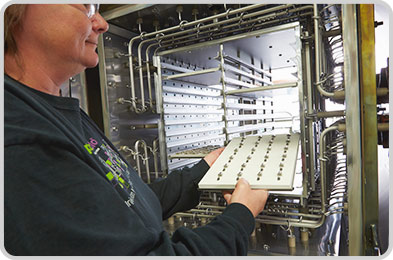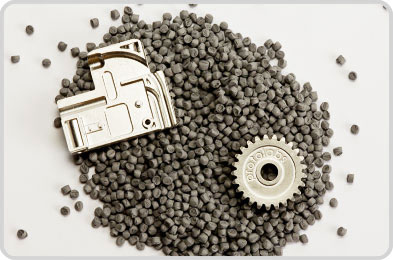 |
| July 08, 2014 | Volume 10 Issue 26 |
Designfax weekly eMagazine
Archives
Partners
Manufacturing Center
Product Spotlight
Modern Applications News
Metalworking Ideas For
Today's Job Shops
Tooling and Production
Strategies for large
metalworking plants
Engineer's Toolbox:
Metal injection molding -- Designing for metal moldability of stainless steel
By Gus Breiland, Customer Service Engineer Manager, Proto Labs
Metal injection molding -- often referred to as MIM -- is a molding process that was developed in the early 1970s and subsequently embraced throughout the manufacturing industry at the start of the next decade. It's a particle materials technology that has existed for the last 40 years, but since the early days of MIM, the molding of metal parts has been a process typically only used when large volumes were needed due to high tooling costs. A mold that is only needed for a few thousand parts is usually too labor intensive and expensive for traditional manufacturers to consider. Using the same methodology that allowed for cost-effective manufacturing of low-volume thermoplastic parts, Protomold now provides product designers and engineers the option of 25 to 5,000+ affordable stainless steel (316L and 17-4PH) parts in less than three weeks.
To better understand how to create a well-designed MIM part, let's start with the process itself. Metal injection molding is a multi-step process that begins very similarly to plastic injection molding. A metal powder suspended in a binder matrix (or feedstock) is injected into a tool where it is heated just like plastic, and the resulting molded parts physically resemble plastic parts. Now in a fragile green state, parts are moved from the injection-molding press into an oven where a catalytic debinding process chemically removes about 80 percent of the plastic polymer. Once the debind process is complete, we're left with even more fragile brown parts that are transitioned from the debind oven to the sintering furnace (see Figure 1). Brown parts are heated to approximately 1,400 C in the furnace, where the remaining binder is removed to form a fully dense metal part.

Figure 1: A Proto Labs technician unloads a tray of metal parts from a sintering furnace during the MIM process.
Stainless steel parts produced in our MIM process tend to be small and are limited to certain constraints. The mass of most MIM parts does not exceed 150 g with a typical mass well below that. Our current maximum part size limits are approximately:
- 4 in. by 4 in. by 4 in. (10.1 cm by 10.1 cm by 10.1 cm);
- No deeper than 2 in. (5.1 cm) from any parting line;
- Maximum projected mold area of 10 sq. in. (64.5 sq. cm);
- Maximum part volume less than 1.25 cu. in. (20.48 cc).
Under some circumstances, it may be possible to extend these limits, but there are tradeoffs. If you need larger parts, please discuss your design and application with a Customer Service Engineer at Proto Labs.
An important consideration when designing for metal injection molding is the proper fixturing of your parts during the debinding and sintering phases to account for shrink and sag. An ideal MIM part has a common co-planar surface that can rest flat to support itself, but we realize that in real-world manufacturing, this is not always the case. There are a few ways to support more complex parts:
- Protomold has a number of trays with built-in support grooves and channels for common geometries found on MIM parts. If your parts require more fixturing attention, we can machine custom trays for additional support, but that can become costly.
- An alternative is to design your MIM part with support fixturing built right into the geometry. If the added support features do not compromise the final product functionally or cosmetically, they can most likely remain on the part. If they need to be removed, they can be machined off in a secondary process.
There is generally a 15 to 20 percent shrink between a green part and fully dense part. Final dimensions are highly dependent on the geometry of the part, and larger parts present more opportunity for variances in final size, but well-designed parts typically achieve linear tolerances of +/-0.005 in. (0.013 cm), plus 0.001 in. (0.003 cm) for each inch of dimension.

From start to finish -- fully dense stainless steel parts sit atop a pile of MIM feedstock.
Metal conducts heat very well, so MIM feedstock (see Figure 2) freezes in the mold much more rapidly than plastic due to its composition of metal particles (along with the mold also working as a heat conductor). As a result, long and/or complex parts can be more challenging to fill. Strategic gate placement, larger gates, or multiple gates should be considered to better facilitate material into the mold. We also run our ProtoFlowTM analysis on each design to detect any issues with material flow before the MIM process begins.
If you've designed for thermoplastic injection molding before, you'll notice that metal injection molding shares a number of similar guidelines. Design features like ribs, gussets, fillets, and radii should be considered to improve the strength of MIM parts; try to observe uniform wall thickness when possible; and although you can occasionally get by with less draft on certain MIM parts -- e.g., shallow parts with good surfaces for ejection -- a standard 0.5 degrees of draft per inch (2.54 cm) of depth on the molded part size (not the final part size) is a good rule to follow.
We're now accepting metal injection molding orders for low volumes of stainless steel parts. Learn more about our new quick-turn process at protolabs.com or call a Customer Service Engineer at 877.479.3680 to discuss any questions you have about MIM. Have a 3D CAD model ready? ProtoQuoteTM can provide an automated quote with moldability analysis and pricing information within hours. Click the ProtoQuote link to see an example.
Published July 2014
Rate this article
View our terms of use and privacy policy
